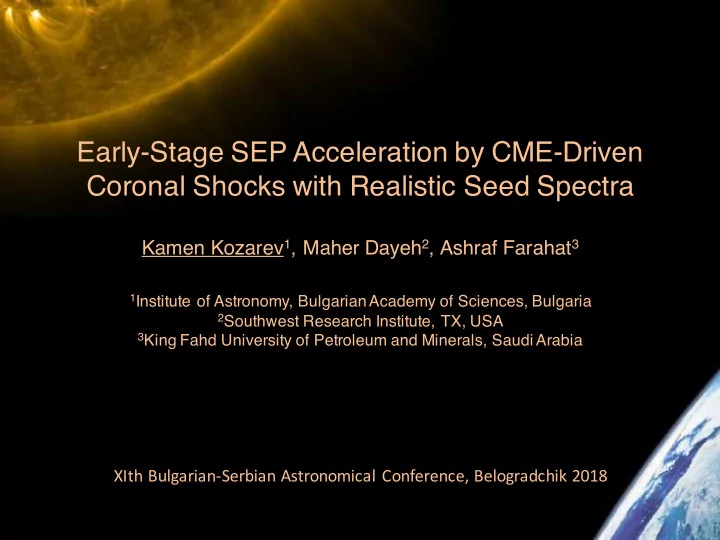

Early-Stage SEP Acceleration by CME-Driven Coronal Shocks with Realistic Seed Spectra Kamen Kozarev 1 , Maher Dayeh 2 , Ashraf Farahat 3 1 Institute of Astronomy, Bulgarian Academy of Sciences, Bulgaria 2 Southwest Research Institute, TX, USA 3 King Fahd University of Petroleum and Minerals, Saudi Arabia XIth Bulgarian-Serbian Astronomical Conference, Belogradchik 2018
Canonical eruption Motivation • Most dynamic region for CME evolution within 5 R sun (Temmer 2016, Bein et al. 2011) • Shocks can form as low as 1.2 Rsun in the solar corona (Gopalswamy et al. 2013) Forbes, 2000 • MHD+kinetic modeling shows protons can be accelerated up to 1 GeV in strong coronal shocks (Kota et al., 2005; Roussev et al., 2004; Kozarev et al., 2013) • Many shock-like EUV waves observed in the corona (Veronig et al., 2010; Kozarev et al., 2011, Nitta et al. 2013, etc.) Temmer (2016) • Can these accelerate SEPs?
Coronal Mass Ejections and EUV Waves June 07, 2011 event
Data-Driven SEP Acceleration Modeling • Global MHD and kinetic models are great – we know everything about the system • However, hard to constrain eruption driver and coronal conditions • Difficult to apply to routine multi-event analysis • Instead, use simpler models, driven by remote observations, for relatively quicker characterization What do we need to model shock particle acceleration? - Shock Kinematics and geometry - Magnetic field strength & orientation upstream of shock - Density & density change at shock - Scattering conditions - Source particle populations
Off-limb CBF Characterization – CASHeW Framework PFSS model from Schrijver & De Rosa, 2003 Kozarev et al., JSWSC, 2017 Current CASHeW methodology : - Radial kinematics estimation (within AIA field of view) - 3D Coronal Shock Geometric Surface (CSGS) model – spherical (from single-view) - Determination of field-front crossing point locations, and angle Theta BN - B field, Density change estimation (DEM model of Aschwanden et al. 2011)
OCBF Characterization The coronal shock parameters can be / have been used to drive shock acceleration models (as in Kozarev & Schwadron, 2016)
Multi-OCBF Event Study 03/27/2011 05/15/2011 10/20/2011 08/04/2011 06/07/2011 Events selected on basis of OCBFs present and source beyond 40 degrees from Sun center 05/26/2012 12/07/2013 11/19/2013 12/12/2013
OCBF Parameters 2011/03/27 Kozarevet al, 2018, in prep.
2011/05/15 2011/06/07 2011/08/04 2011/10/20 Kozarev et al, 2018, in prep.
2012/05/26 2013/11/19 2013/12/07 2013/12/12 Kozarev et al, 2018, in prep.
Analytical data-driven DSA model A first step towards remote data-based early-stage SEP prediction - Solves analytically for the diffusive shock acceleration of ions - Developed specifically to take parameters from the CBF characterization - Accounts for minimum injection momentum - Ad-hoc scattering conditions (constant mean free path currently) - Source population taken from coronal kappa distribution 11 Kozarev & Schwadron, 2016
Data-driven DSA model - Validation 12 Kozarev & Schwadron, 2016
Input Suprathermal Spectra - ACE/ULEIS+SIS Oxygen observations from a recent study (Dayeh et al., 2017) - Quiet-time, pre-event suprathermals (0.05-0.55 MeV); no source particles beyond 0.55 MeV Scaled to p + fluxes, assuming relative O abundances - of 0.064 +/- 0.01% (Reames 2014) Scaled to 1.05 R sun assuming 1/R 2 flux dependence - Kozarev et al, 2018, in prep.
Resulting Spectra – 06/07/2011 event
Resulting Spectra Kozarev et al, 2018, in prep.
Shock Parameter Dependence Kozarev et al, 2018, in prep.
Conclusions and Prospects - High-cadence, high-resolution remote observations with AIA, combined with data-driven models allow estimation of wave/shock kinematics, density changes, magnetic field. These can be used to drive SEP acceleration models. - A multi-event study of OCBFs has been carried out to estimate the amount of acceleration on protons during the very early stages of 9 eruptions; - We have used the time dependent properties within the AIA FOV to drive directly a DSA particle acceleration model - We find a range of maximum energies reached and spectral indices - Strong acceleration results from stronger shocks and longer acceleration times Where we are headed: - Improve the description of shock geometric shape, include lateral measurements - Improve determination of shock scattering conditions - Extend OCBF characterization to beyond AIA FOV (LASCO), include interplanetary transport to 1 AU for validation of SEP modeling results
Extra Slides
Data-driven DSA model Application to May 11, 2011 event - Model was run on 176 field lines crossing the shock surface - We found weak acceleration, due to the small density enhancement inferred - More significant acceleration if increase the density compression - Need to improve the scattering description - First step taken towards remote data-driven modeling of coronal SEP acceleration 19 Kozarev & Schwadron, 2016
Recommend
More recommend